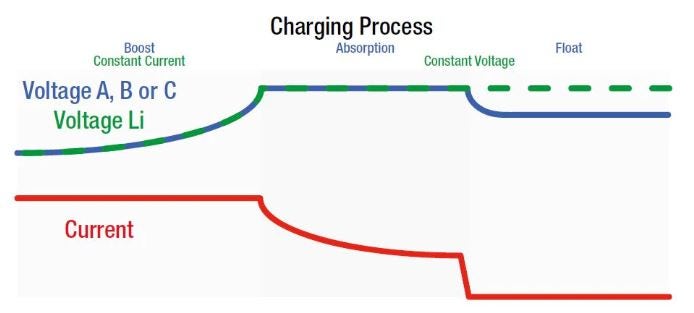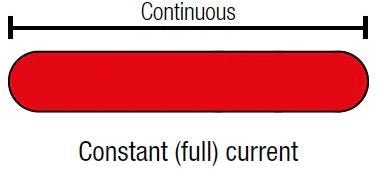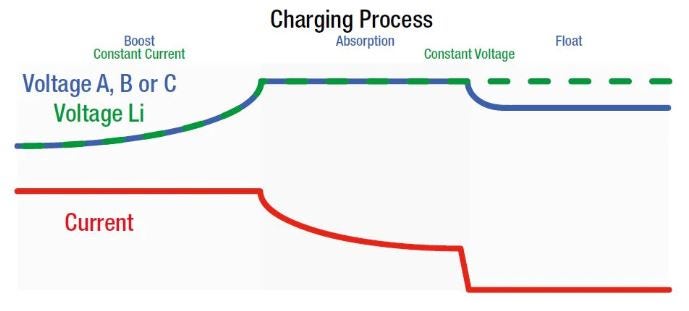What is my BCDC charge status LED telling me?
My BCDC’s charge status LED indicates Boost/Constant Current stage, but my auxiliary battery’s voltage is less than 14V. Is it charging?
The operation of the charge status LED will vary depending on the model and application of charger used. For this reason, this tech tip it broken into three parts;
BCDC1220(-IGN), BCDC1225(-LV), BCDC1240(-LV)
BCDC1225D/BCDC1240D (A, B or C Profiles)
BCDC1225D, BCDC1240D (Li Profile Only)
BCDC1220(-IGN), BCDC1225(-LV), BCDC1240(-LV)
The BCDC1220, BCDC1220-IGN, BCDC1225, BCDC1225-LV, BCDC1240 and BCDC1240-LV feature REDARC's proprietary three-stage charging algorithm. These stages are:
Boost:
In this stage the LED is on solid and the BCDC is applying maximum current to the battery. It maintains a constant current until the battery voltage reaches its maximum voltage. The voltage will gradually rise in the battery as its state of charge increases. Generally, Boost stage will deliver the first 70- 80% state of charge, depending on the battery type. The current in boost stage may vary during operation to maintain safe operating temperature, or to limit the difference between input and output voltages.
What you would expect to see on a multi-meter in BOOST stage:
Voltage: Between the battery resting voltage and absorption voltage, will increase gradually as battery charges.
Current: Full charger capability, will stay constant until the voltage rises to the maximum charge voltage.
The LED will indicate Boost when the full charge current is being applied. As the battery voltage reaches the maximum charge voltage the LED will flash to indicate the current into the battery is falling. A shorter duty-cycle (shorter illumination time of the LED) indicates less current into the battery.
Absorption:
Once the battery reaches 100mV less than the Maximum Charge Voltage (e.g. 14.5V for profile A selection), the charger will hold the absorption voltage for a predetermined period of time or until the current being drawn by the output battery drops to less than 4A for 30 seconds; after which the charger will enter Float stage. The battery is fully charged at this time.
What you would expect to see on a multi-meter in ABSORPTION stage:
Voltage: Will be stable at the Absorption voltage (e.g. 14.5V for profile A selection).
Current: Will be gradually falling. When the current falls below 4A for 30 seconds the charger will enter Float stage.
The LED will indicate Absorption when the full charge voltage is being applied. As the charging current decreases the LED will flash to reflect this. A shorter duty-cycle (shorter illumination time of the LED) indicates less current into the battery. Note: the charger’s output current will change in line with any loads applied to the battery to prevent the need for the BCDC to skip or revert stages.
Float:
The BCDC will reduce current to the battery to allow the voltage to fall to its Float voltage of 13.3V. It will then maintain this voltage in order to keep the battery topped up. This counteracts the battery’s self-discharging or any loads applied to the battery. When the battery loses charge due to a load more than its maximum current is applied, the charger will move back into the Boost stage.
What you would expect to see on a multi-meter in FLOAT stage:
Voltage: Will be stable at the Float voltage (13.3V).
Current: Will be relatively low, unless a load is applied at which time it will be slightly higher than the load current.
The LED will indicate Float when the battery is fully charged. As the battery current changes the LED will flash to reflect this. A shorter duty-cycle (shorter illumination time of the LED) indicates less current into the battery. Note: the charger’s output current will change in line with any loads applied to the battery to prevent the need for the BCDC to skip or revert stages.
LED current output indication:


For an illustrated view of the BCDC charge profile, see the diagram below


BCDC1225D/BCDC1240D (A, B or C Profiles)
The BCDC1225D and BCDC1240D feature REDARC’s proprietary three-stage charging algorithm. These stages are:
Boost:
In this stage the LED is on solid and the BCDC is applying maximum current to the battery. It maintains a constant current until the battery voltage reaches its maximum voltage. The voltage will gradually rise in the battery as its state of charge increases. Generally, Boost stage will deliver the first 70- 80% state of charge, depending on the battery type. The current in boost stage may vary during operation to maintain safe operating temperature, or to limit the difference between input and output voltages.
What you would expect to see on a multi-meter in BOOST stage:
Voltage: Between the battery resting voltage and absorption voltage, will increase gradually as battery charges.
Current: Full charger capability, will stay constant until the voltage rises to the maximum charge voltage.
The Stage LED will be on solid to indicate Boost when the full charge current is being applied.
Absorption:
Once the battery reaches 100mV less than the Maximum Charge Voltage (eg 14.5V for profile A selection), the charger will hold the absorption voltage for a predetermined period of time or until the current being drawn by the output battery drops to less than 4A for 30 seconds; after which the charger will enter Float stage. The battery is fully charged at this time.
What you would expect to see on a multi-meter in ABSORPTION stage:
Voltage: Will be stable at the Absorption voltage.
Current: Will be gradually falling. When it is below 4A for 30 seconds it will enter Float stage.
The Stage LED will flash once per second to indicate Absorption when the absorption voltage is being applied.
Note, the current may change in line with any load applied to the battery without the need for the BCDC to skip or revert stages.
Float:
The BCDC will reduce current to the battery to allow the voltage to fall to its Float voltage of 13.3V, where it will then maintain this voltage, keeping the battery topped up. This counteracts the battery’s self-discharging or loads applied to the battery. When the battery loses charge due to a load more than its maximum current is applied, the charger will move back into the Boost stage.
What you would expect to see on a multi-meter in FLOAT stage:
Voltage: Will be stable at the Float voltage.
Current: Will be relatively low, unless a load is applied at which time it will be slightly higher than the load current.
The Stage LED will flash once every 2 seconds to indicate Float when the battery is fully charged.
Note, the current may change in line with any load applied to the battery without the need for the BCDC to skip or revert stages.
LED current output indication:


For an illustrated view of the BCDC charge profile, see the diagram below:


BCDC1225D, BCDC1240D (Li Profile Only)
The BCDC1225D and BCDC1240D feature REDARCs proprietary charging algorithm for Lithium Iron Phosphate batteries. The stages are Constant Current and Constant Voltage.
Constant Current:
When turns on, it will start in Constant Current stage. In this stage the LED is on solid and the BCDC is applying maximum current to the battery. It maintains a constant current until the battery voltage reaches its maximum charge voltage. The voltage will gradually rise in the battery as its state of charge increases. Generally, Constant Current stage will deliver the first 90-95% state of charge, depending on the battery. The current in this stage may vary during operation to maintain safe operating temperature, or to limit the difference between input and output voltages.
What you would expect to see on a multi-meter in CONSTANT CURRENT stage:
Voltage: Between the battery resting voltage and maximum voltage, will increase gradually as battery charges.
Current: Full charger capability, will stay constant until the voltage rises to the maximum charge voltage.
The LED will indicate Constant Current when the full charge current is being applied.
The stage LED will be on SOLID


Constant Voltage:
Once the battery reaches its Maximum Charge Voltage of 14.6V, the charger will hold the Constant Voltage 14.5V. It will maintain this voltage, to fully charge the battery and keep the battery topped up. This counteracts the battery’s self-discharging or loads applied to the battery. When the battery loses charge due to a load more than its maximum current is applied, the charger will move back into the Constant Current stage.
What you would expect to see on a multi-meter in CONSTANT VOLTAGE stage:
Voltage: Will be stable at the Constant voltage.
Current: Will be gradually falling to a relatively low level, unless a load is applied at which time it will be slightly higher than the load current.
LED current output indication:
The LED will indicate Constant Voltage when the full charge voltage is being applied.
The LED will flash TWICE early in the Constant Voltage stage, and ONCE when the battery is fully charged.


For an illustrated view, see the diagram below:


* When using the battery charger to charge a Lithium Iron Phosphate battery, only batteries that feature an inbuilt battery management system featuring inbuilt under and over voltage protection and cell balancing are suitable.
For further information or assistance contact REDARC Technical Support.
